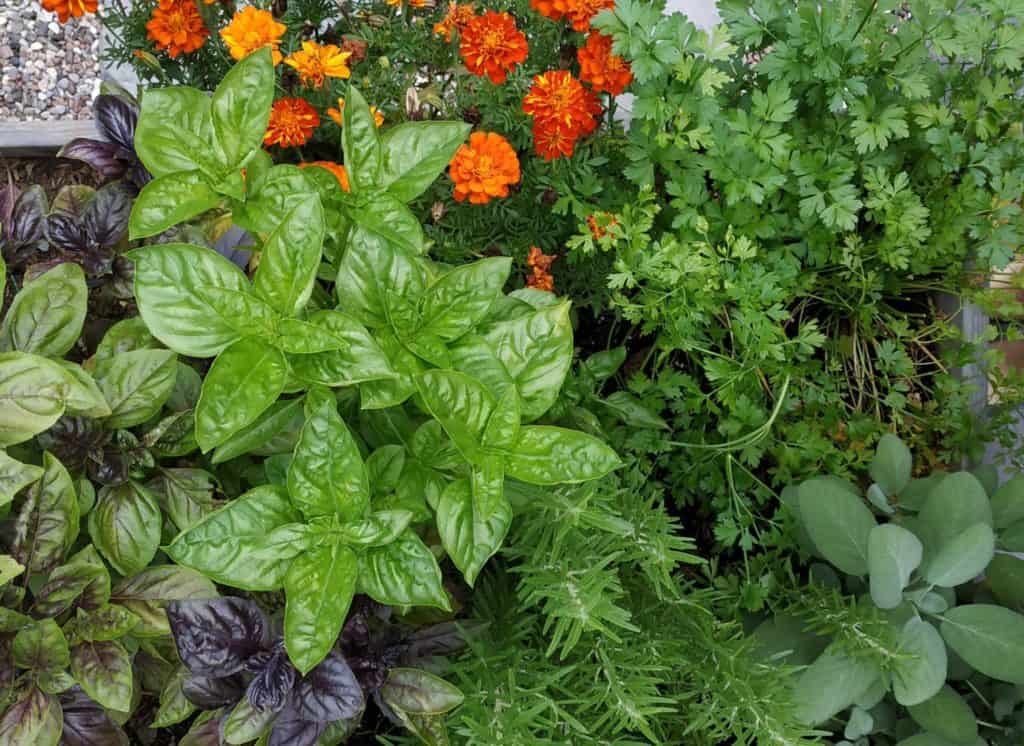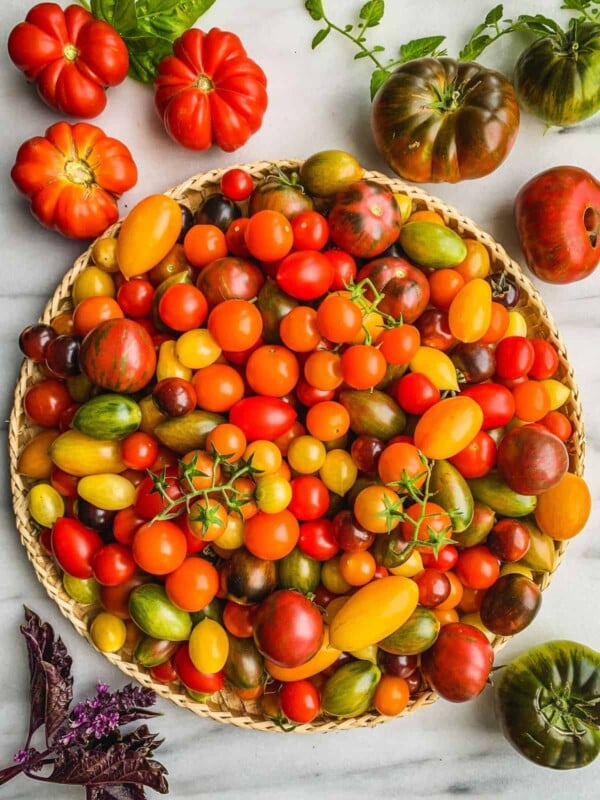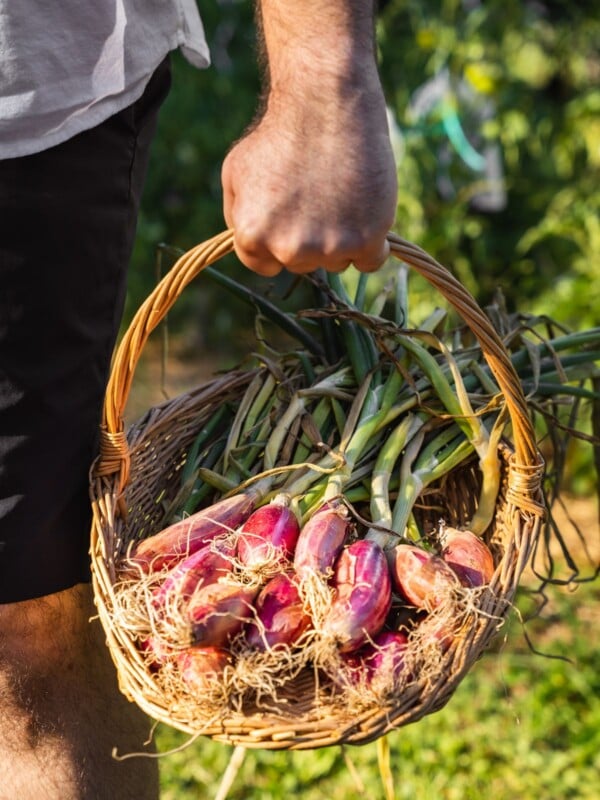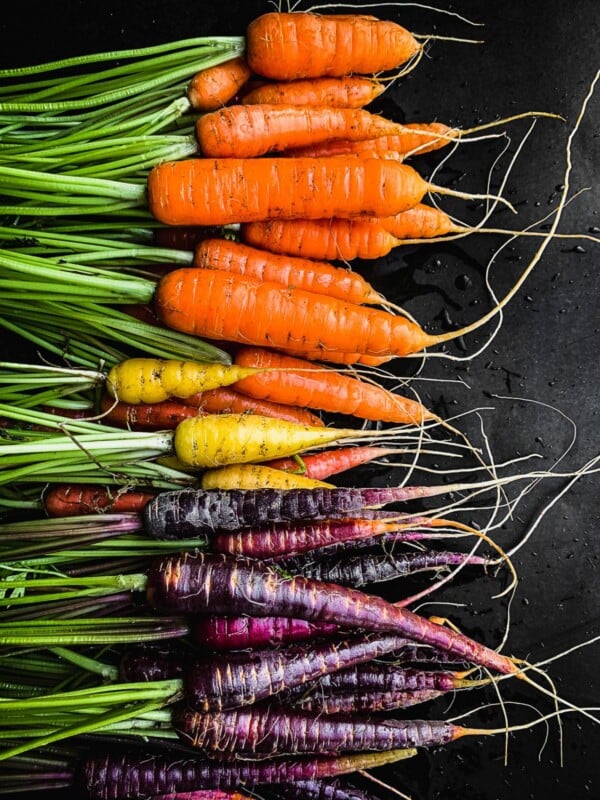Here are my top 8 herbs to grow yourself at home to ensure quality, reduce food waste and save money in the process.
Who’s guilty of buying a bunch of parsley, using a handful and letting the rest turn to mush in the back of the crisper? I certainly am, especially during the winter months when the garden is asleep. During the spring/summer/fall however I tend to not purchase herbs from the grocery store at all.
Growing your own herbs is actually not that difficult. Herbs tend to be pest resistant. They don’t require much space in the garden. They can also be grown in containers on your balcony or windowsill. Depending on your climate, some will come back year after year, considered perennials (sage, mint, oregano, chives, thyme and more). Others will be considered annuals (basil, cilantro, chervil, parsley and more). Annual herbs tend to self-seed, meaning that they will flower (if you let them) and go to seed which will fall to the ground and sprout. You can also save the seeds and use them to grow new seedlings or as food.
In my climate, where we get a cold winter and deep freeze, I cannot grow any herbs outdoors through the winter. My perennial herbs do come back in the spring, but when it comes to annuals, I have to start them from seed or purchase seedlings from the garden centers.
So why grow your own herbs?
- Compared to other crops, they provide a great return on investment
- They are easy to grow
- Dry and preserve your homegrown herbs for use throughout the winter months
- You can pick and choose new and unique varieties
Biggest bang for your buck!
The Return on Investment that you get from growing your own herbs is unmatched. Just think about your favorite recipe. For example, Beef Bourguignon. Most recipes will call for thyme, parsley, bay and possibly rosemary. If you didn’t have any of these herbs in your fridge, you’d have to go out and purchase 4 different containers of herbs. The recipe may call for 5 sprigs of thyme, but the store only sells containers with 40+ sprigs. The chances of using up the rest of the container are slim, and will probably end up in the compost or garbage in a week’s time.
Many of these herbs are sold in plastic clam-shell type containers and are also being trucked or flown thousands of miles/kms. Their carbon footprint is unnecessarily high. I was shocked to see that a container of thyme I needed to purchase recently was grown in Israel. That Thyme flew 10,000 kms to get to my kitchen. Unacceptable!
If you’re growing your own herbs, you can simply use what you need for a given recipe. You don’t have to worry about food waste. The carbon footprint associated with growing your own herbs will be negligible.

Easy to Grow
Herbs are so easy to grow and can be planted in the ground, raised beds, containers, grow bags, or even hydroponically. I personally grow perennial herbs in the ground or in raised beds (so that they can come back year after year) whereas annuals are grown in containers and hydroponically indoors during the winter.
Herbs can be started from seed, grown from cuttings or seedlings. If you’re not interested in seed starting indoors then purchase seedlings from your favorite garden center in the spring (no shame in buying seedlings… I do it too. I don’t have the indoor space or grow lights to start everything I’d like to grow from seed myself).
Preserve your harvest
Another great reason to grow your own herbs is that you can harvest and preserve as you need. For example, I will cut back all my basil and make big batches of pesto several times throughout the summer. This encourages the plants to keep putting out more leaves. More leaves means more pesto, more fresh basil for salads and sauces and more basil to share with friends and family.

Another way to preserve the harvest is by drying your herbs . I dry rosemary, thyme, oregano and mint every year. You can air dry, oven dry, dehydrate or even microwave! Yes, you can dry herbs in the microwave!
Which herbs to grow!
These are my personal favorite herbs to grow because I tend to use them regularly in my cooking. Having access to them in the garden just makes my life easier. When I making a salad and I need some herbs, I just take 20 steps out to my herb garden and take what I need.
Basil
I mean, was there even a question that basil was going to be on this list? This herb is so versatile, with its fresh and herbaceous flavor. Not all basil is the same. There’s Genovese Basil, Sweet Basil, Thai Basil, Holy Basil, Cinnamon Basil, Purple Basil, Spicy Globe Basil, Ruffled Basil… They each have their own distinct flavor, color, texture and shape. I tend to grow different varieties. If you have room for 1 type of basil, think of the typical cuisine you cook. If you tend to cook Italian, then grow Genovese. Is South East Asian cooking your jam? Then grow Thai Basil.


I tend to cook dishes from all over the world and love using different herbs so I will typically grow 4-5 varieties of basil.
Basil has some great properties:
- Aiding in digestion
- Full of antioxidants
- Good source of vitamins (100g of basil contain 395% of your daily requirement of Vitamin K)
- Good source of minerals (100g of basil contains 55% of your daily requirement of manganese)
Grow: Basil can easily be started from seed. You can also purchase nursery starts in the spring and get a head start on the growing season. It’s also quite common to find basil plants in your grocery store produce section.
Pro Tip: Basil can easily be propagated. You can take stem cuttings, place them in water and they will sprout roots. You can then transplant into soil and voila, you have a new basil plant.
Rosemary
A classic! Rosemary is a fragrant woody herb with evergreen-like needles and white, purple or blue flowers. It is native to the Mediterranean and a staple in European Cuisine.
I use fresh rosemary in marinades, with roasted vegetables, in strews and broths. Because it is a woody herb it can stand up to prolonged cooking. It is a traditional flavoring for lamb, beef and chicken.
There are many claims about the health effects of rosemary or rosemary essential oil. I grow it because it adds flavor to my dishes and not for any of its supposed health benefits.
Grow: Rosemary is not easy to grow from seed. In fact, I would not recommend it at all. Purchase seedlings from your favorite garden center or nursery.
Pro Tip: Rosemary can also be propagated. You can take stem cuttings, place them in water and they will sprout roots. You can then transplant into soil and voila, you have a new rosemary plant. They are more difficult to propagate than basil, but worth trying.
Thyme
Another Mediterranean classic. Ancient Egyptians embalmed their mummies with it. Greeks burned it as incense to foster courage. During the Middle Ages people thought it would ward off nightmares.
Thyme is a woody herb with small evergreen type leaves. It is related to oregano and has a distinct earthy flavor. A staple herb in Middle Eastern Cuisine and a critical component of Za’atar, a spice mixture or condiment containing thyme, marjoram, sesame seeds, and sumac (recipes differ by region and even family).
It forms a standard component of a “Bouquet Garni”, a bundle of herbs used to flavor stocks, soups and stews.
From a nutritional standpoint, I would say that any benefits are negligible since you’re using such a small quantity in your cooking to begin with. However, it does contain Vitamin A, C, Iron and magnesium among others.
Grow: Since it is a woody herb that grows slowly, I recommend you purchase seedlings from your nursery or garden center. I like to plant thyme in both containers and in the ground. It is a perennial, so it will come back if planted in the ground and mulched well in the fall.
Pro Tip: At the end of the season, harvest and dry. Dried Thyme is very potent and a little goes a long way. Add it to your hearty sauces, stews, roasted vegetables and long meat braises.
Mint
Refreshing, cooling, and downright fresh. Mint is one of those herbs that has so many uses. It can be used in savory dishes, in desserts, in drinks (Mojito!), teas and more. There are several types of mint (spearmint, peppermint, chocolate mint, apple mint and mote) each with its distinctive flavor and growing habit.
Mint can also be dried and preserved for future use. Dried mint with cucumber and yogurt makes a great Tzatziki style dip or side dish. I also use dried mint for herbal tea. I use it as garnish on fruit tarts, in Vietnamese spring rolls, in Middle Eastern dishes and in Thai green mango salads.
Grow: Can you grow mint from seed? Sure. Should you? That’s up to you. My preference is to purchase nursery starts and get a head start. Mint grows like a weed. The cool thing about mint (or annoying thing if you’re trying to keep it contained) is that it will send out shoots all over the place. Plant it once and you’ll find mint shoots in every nook and cranny of your garden. This is why it is considered invasive by many gardeners.
Pro Tip: Grow mint in a container. Mint spreads and overtakes everything in its path. Limiting that path will allow you to enjoy this herb without sacrificing your garden in the process. Keep the container watered as mint is a thirsty herb.
Parsley
I grow parsley for one primary reason: to avoid food waste. I cannot tell you how many times I have had to throw out a mushy rotten bunch of parsley from my fridge. When you buy parsley at the store, they sell it in these big bunches. Unless you’re a rabbit and snack on it for fun, you’ll probably never go through that bunch in a week. I find that wasteful.
Most recipes will call for a handful of parsley, or a few tablespoons. Growing my own means I get to harvest the quantity I need for a given dish. You also can’t beat fresh, yard to table flavor.
From a nutritional standpoint, parsley is packed with Vitamin A and Vitamin C. It has a good amount of iron as well.
Grow: Parsley can be grown from seed quite easily. You can also purchase nursery starts in the spring. Parsley is considered a biennial, meaning that it will only go to seed in its second year. The first year it will put out foliage (which is what we want). If the plant is stressed in the first year, it may bolt and send out flowers as a coping mechanism, so give the plants ample room to grow. Parsley grows like weeds so one tiny seed can provide you with enough parley for the season! It’s not a fussy plant, but will be happy if you keep it watered, fed and mulched.
Parsley does attract swallowtail caterpillars which will then turn into beautiful swallowtail butterflies so don’s be afraid to share your harvest with a few caterpillars.

Pro Tip: Make parley butter! Finely chop excess parley and add it to softened butter. Form into a log and refrigerate. Once cold, slice the log into coins and then cover well with plastic wrap and freeze. Now you have homegrown parsley butter available all winter to add to strews, top steaks and use for garlic bread!
Cilantro/Coriander
Probably the most polarizing herb out there. You either love it or hate it. For those that hate it, it may have to do more with genetics than preference. Some people have a genetic variation in a group of olfactory-receptor genes that enhances certain soapy flavor profiles in cilantro. I can see why that would be unpleasant.
However, if you do not have this genetic disposition, I highly recommend your grow your own cilantro, especially if you cook Mexican, Latin or Asian food. It is a great finishing herb on tacos, meat dishes, curries and more.
What’s great about cilantro is that the entire plant is usable. The roots can be cleaned and chopped and used in a thai curry. The stems can be added to a salsa or blended with lime and oil to make a dressing. The leaves can be used as garnish. And of course, the seeds of the cilantro plant (called coriander) can be used as a spice as well.
Grow: Cilantro can be started from seed quite easily. I grow successions of cilantro, meaning that I will start seeds every 10-14 days. This succession planting technique ensures that I have plenty of cilantro available to harvest in the spring and early summer. Cilantro hates heat, so I only grow it in the spring/early summer and in the fall.
Pro Tip: Cilantro tends to bolt in the summer heat. Grow it in containers in the spring, and move the containers to the shade when the weather warms up. This won’t prevent bolting, but will delay it slightly. Also, let your cilantro bolt. It will flower and then create coriander seeds, which you can harvest when dry and use in cooking or replant.
Chives
Old Faithful. Plant once, enjoy for years. That’s what I love about chives. They return year after year and don’t care how cold the winter is. Chives are an Allium (member of the onion family). They produce wonderfully scented and flavorful lilac/purple flowers.

Culinarily, they are used as a finishing herb on top of mashed potatoes, in salads, on top of roasted vegetables. They add a mild oniony and fresh flavor to hearty dishes. I also enjoy the flowers when they bloom. I will snip off the flowers and scatter them atop ceviche, mash potatoes or cooked fish.
From a nutritional standpoint, they packed with Vitamin A and Vitamin C.
Grow: You can start chives from seed, but in my opinion, you’re better off buying a nursery start and saving yourself the hassle of seed starting an allium. I have been growing chives in a small terracotta pot for 5 years now. I ignore it… neglect it… don’t feed it and yet it comes back year after year with enough chives to last me through the spring and summer.
Pro Tip: Harvest aggressively. This encourages more growth. Any chives that you do not use in your cooking can be stored in a damp paper towel inside a plastic bag in the fridge.
Sage
Sage is a woody herb with blue gray leaves. There are some purple and variegated varieties of sage as well. It is native to the Mediterranean but it is now commonly found throughout the world. It is primarily used in culinary applications, like marinades, slow roasts and flavoring for sausage and beans. Most people think of Thanksgiving or Christmas turkey as the only times you would use sage, but that’s definitely not the case.
I add sage to roasted potatoes, to roasted vegetables, inside meatballs and other preparations.
Sage burning, or smudging, is a traditional ritual performed by Natives for spiritual cleansing and purifying.
Grow: Sage is a perennial, so it will come back year after year. I purchase nursery starts for different varieties and plant some in containers and some in the ground. It is not a fussy plant and generally pest resistant.
Pro Tip: Fry up some sage leaves in brown butter until crispy (but not burned). Spoon flavored brown butter and crispy sage on top of cooked ravioli and enjoy. Delicious!












